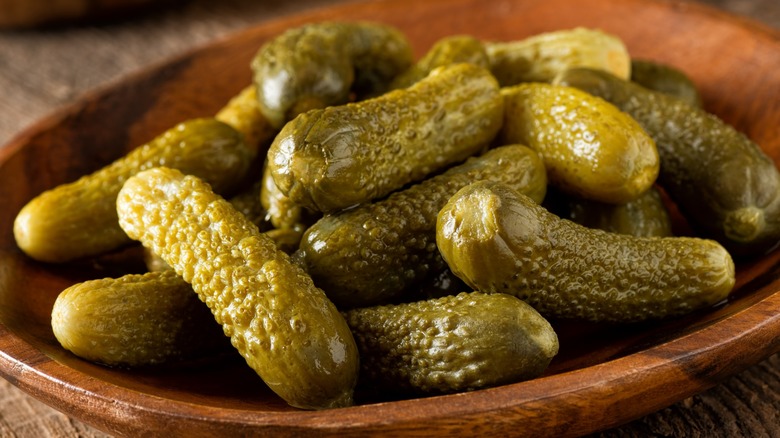What Actually Is A Pickle? The Debate, Explained
If it looks like a pickle and tastes like a pickle, isn't it a pickle? While there are many unique ways to boost pickle flavors, a pickle just isn't a pickle without that distinct, tangy taste. Still, one would assume that all things pickled, are, in fact, pickles. But, as it turns out, the semantics aren't so simple — and a Washington dad's recent August 2023 rant on TikTok stirred up quite the pickling debate.
Jesse Banwell was fixing a few sandwiches for his kids and reached for a jar of Claussen pickles only to find that nowhere on the package did it actually read the word "pickles." Confused, he reached for a jar of Mt. Olive pickles hiding in the back of the fridge, and, to his surprise, the word "pickle" wasn't to be found there, either. It seems that most brands actually refer to their products as things like "sandwich slices" and "hamburger chips" rather than "pickles."
So, what exactly is a pickle? It's time to crack the case. Believe it or not, the United States has pickle standards. While there are many specifics to defining a pickle, the U.S. Department of Agriculture (USDA) confirms that, to be considered pickles, the product must be prepared with cucumbers, or at least composed primarily of cucumbers. However, that's just the beginning.
Pickles are all about the process
The most common pickle, the one you'll likely find alongside your sandwich, is made from cucumber. The process of pickling completely changes the flavor of the vegetable, so it's hard to imagine that crisp, tangy pickles are made from light, fresh cucumbers. Pickling is the act of preserving something in a brine of vinegar, sugar, and salt, and classic dill pickles are made with garlic and specific spices including mustard seed, coriander, dill, and allspice.
Considering that it's the technique that ultimately creates the ubiquitous pickle, just about any vegetable can be pickled, but that doesn't mean that artisans can slap "pickle" on the label. The U.S. Food and Drug Administration (FDA) has strict rules when it comes to labeling food products, but, when the product is easily recognizable, brands can be more creative with naming. As Vlasic brand manager Carolyn Goldberger told TODAY.com, "Because of the wide variety of our pickle forms, we use the limited label space to clearly communicate the form and flavor inside each jar."
Aside from the fact that the product has to be predominantly cucumber, the USDA outlines various other pickle guidelines such as precise pH levels, Brix value, acidity, and equalization. It seems that big pickle brands like the ones that caught Jesse Banwell's attention, as well as Vlasic and B&G, dodge the term "pickle" simply to give themselves more culinary freedom. By leaving the terminology loose, these brands are free to explore a variety of approaches without limitations.

